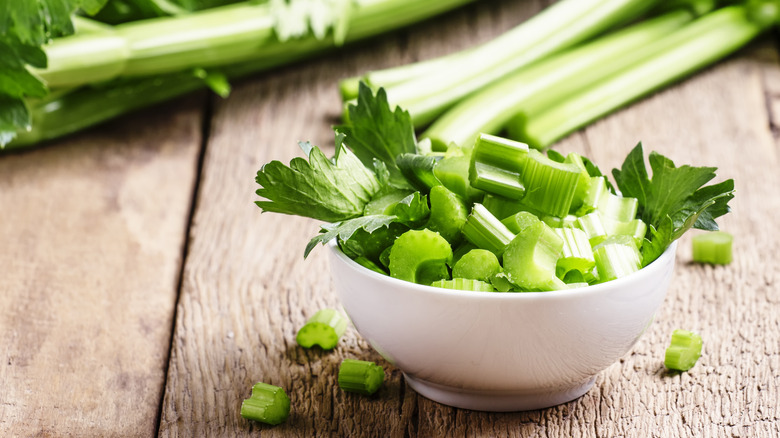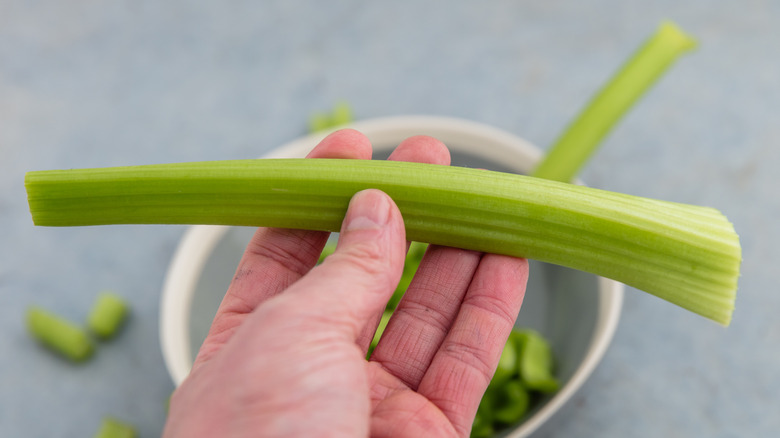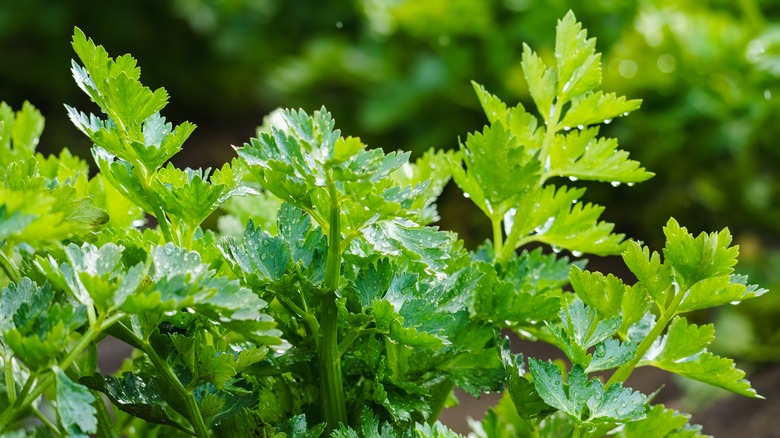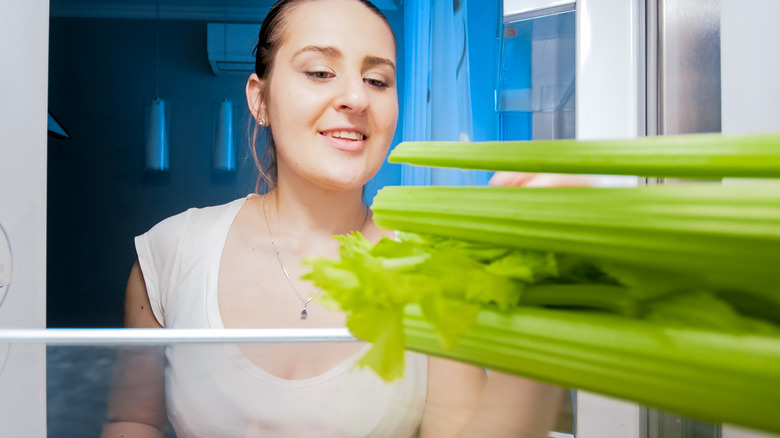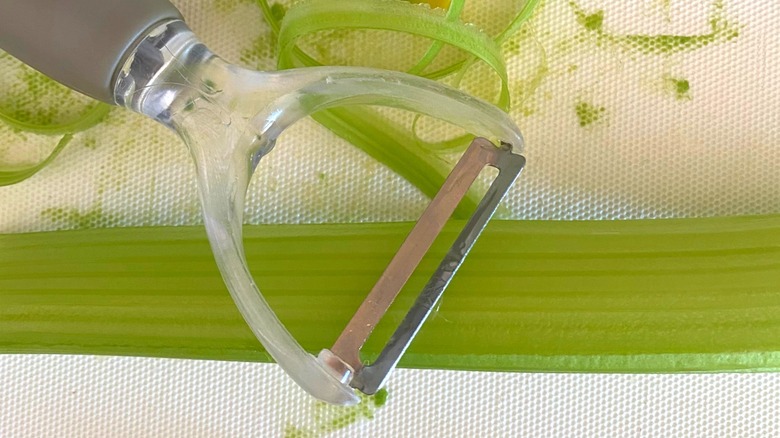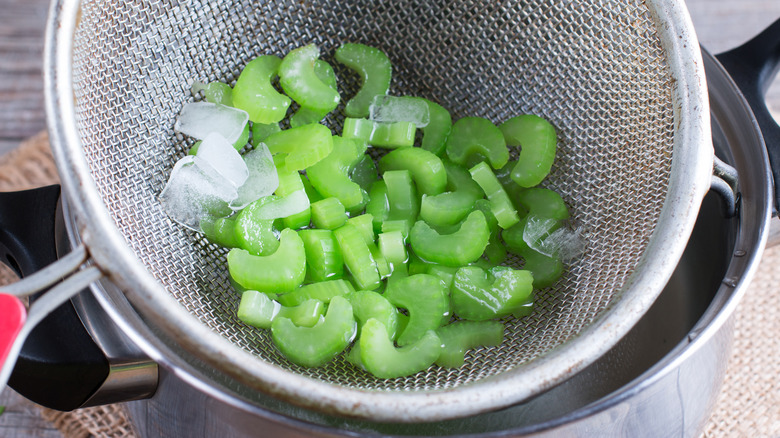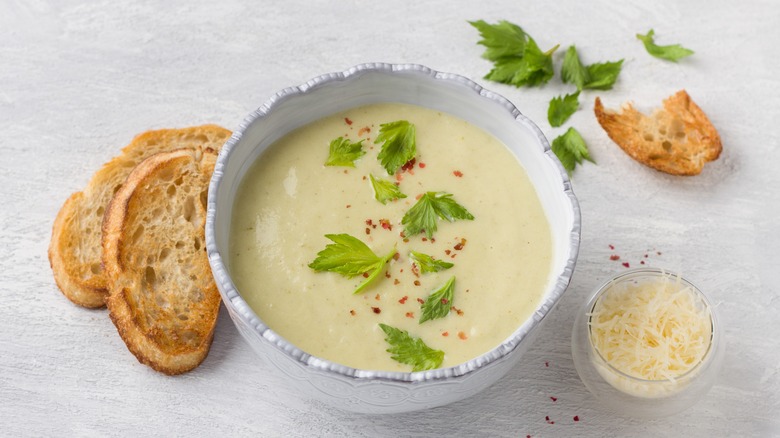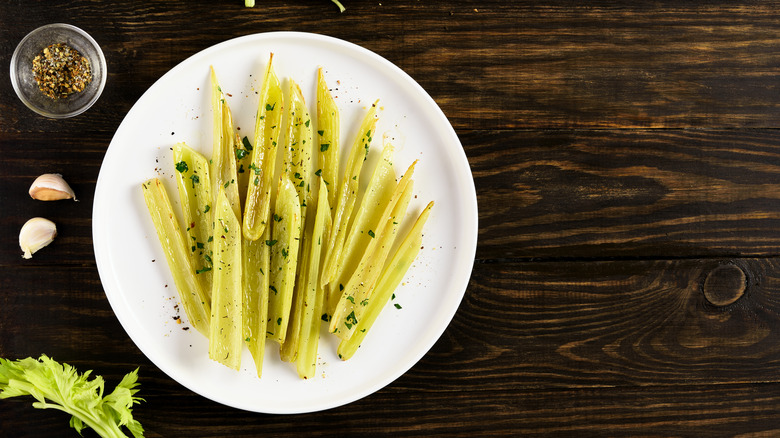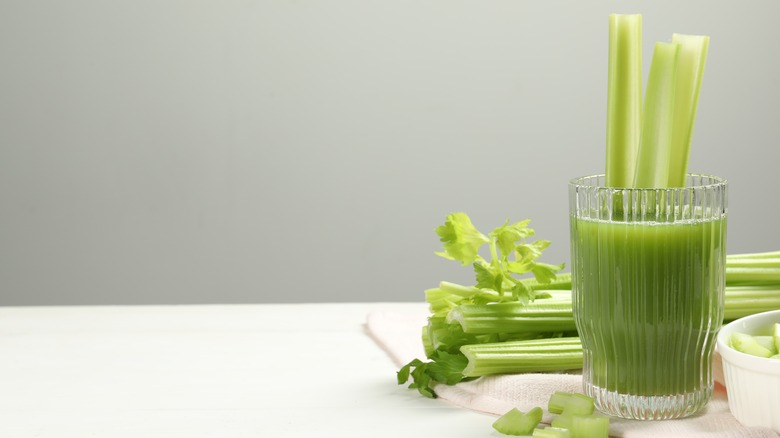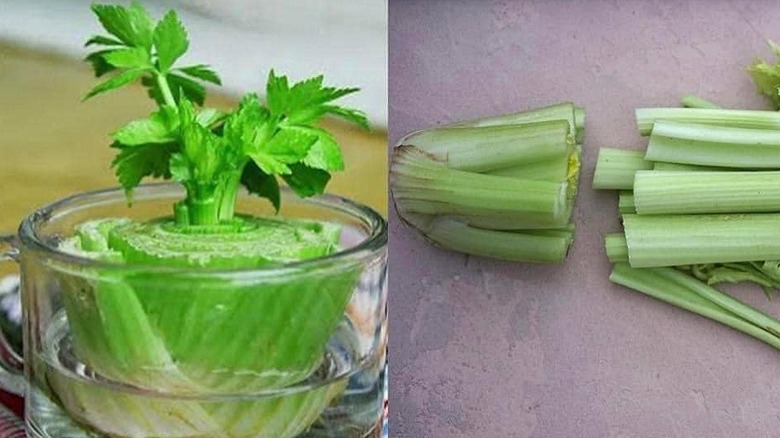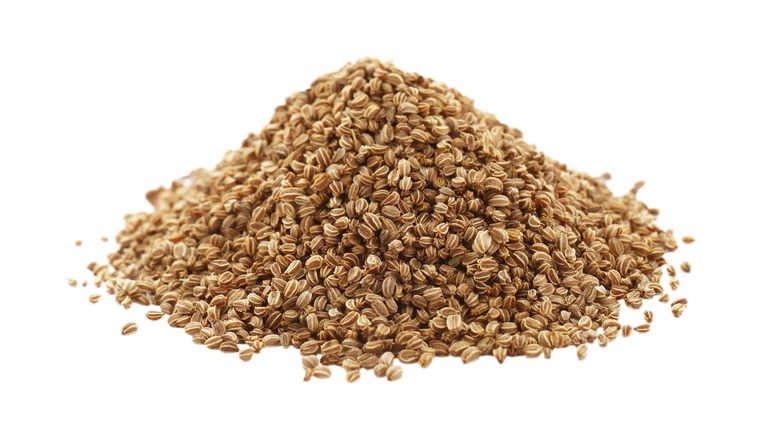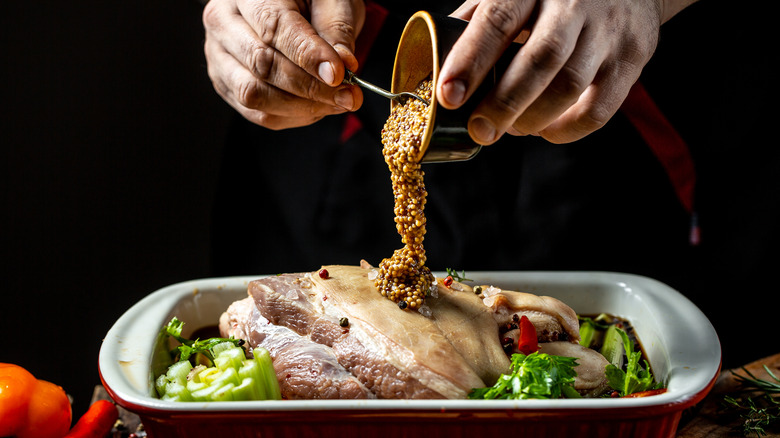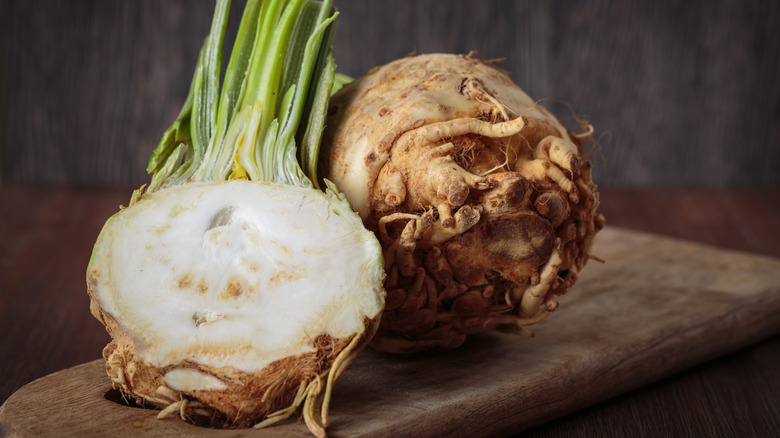14 Mistakes Everyone Makes When Cooking With Celery
Celery is a vegetable that often gets overlooked. Either it is perceived as having no flavor or is only seen as a useful vessel for toppings. However, when prepared properly, it can be a tremendously tasty ingredient. One need look no further than a classic mirepoix to recognize the utility of this vegetable in recipes. Without celery, the base for most soups and stews would lack one of its fundamental building blocks for developing the complexity of these recipes.
When certain mistakes are avoided, celery can be a fantastic ingredient to work with. From the way it is stored to how it is cut to only relegating it to a vegetable tray, there are a number of missteps that can prevent this vegetable from living up to its full potential. It takes the skill and knowledge of an expert to transform these verdant stalks into spectacular culinary works of art.
That's where I come in. I have nearly two decades of experience as a professional chef under my belt, and I am prepared to share some not-so-top secret tips and tricks to help you avoid making these fatal errors with this under-appreciated vegetable. Read on to discover how celery can become one of your favorite new ingredients to work with in the kitchen.
1. Mistake: Not buying fresh celery
Many people don't really know what to look for when it comes to buying celery. It is often sold in grocery stores already cut into sticks or without leaves. If you do find whole bunches with the leaves intact, these are often past their prime. Fresh celery should be firm, crisp, a light green hue, and have a bright, grassy, musky aroma. Its leaves will vary in size, but often resemble Italian parsley. Any signs of bruising, mold, floppy stems, or stalks that are visibly dry indicate the celery is not fresh and should not be purchased.
While you will typically only find one type of celery at the grocery store, namely the Pascal or stalk variety, there are others out there that you may find at a local farmer's market or specialty retailer. One that I commonly keep an eye out for is leaf celery, which has thin stalks and larger, dark green leaves. It is extremely bold in flavor and scent, making it ideal for adding to soups and stews. There are also heirloom iterations, including golden and red varieties, which add bold color to salads.
2. Mistake: Only using the stalks
I always seek out celery bunches that have abundant leaves that I can use in raw and cooked dishes of all kinds. Celery leaves should be used the way you would other fresh herbs; they can be added to any recipe for a pop of color, and a strong, slightly bitter, grassy flavor.
The leaves are particularly great when added to a salad. They can be incorporated directly into your lettuce mix. I often pair celery leaves with sweeter components that can help balance out their inherent bitterness, like fruit. I also enjoy complementing them with tart ingredients, like dried cherries or currants. Lastly, dress this salad with a vinaigrette that has bold acidic elements, which will amplify the herbaceous undertones of celery leaves, while taming their bite.
Another place where celery leaves can shine, is when tossed into an Asian-inspired stir fry. Most stir fry recipes rely on bold aromatics, like garlic and ginger, umami-rich condiments, like soy sauce or miso paste, and a spicy element, like gochujang or sriracha, which confer a complex layer of flavors into the dish. What's often missing is a bright, refreshing ingredient to pull these elements together. Celery leaves can serve as this component, when added toward the end of the cooking process so that they retain their crunchy texture and bright color.
3. Mistake: Storing it improperly
Celery is a fickle vegetable to store due to its high moisture content and penchant for colder temperatures. While most celery is sold wrapped in plastic, this is the worst encasement. As the vegetable begins to age, ethylene gasses will get trapped, causing it to spoil more rapidly, become mushy, and develop mold.
The best way to store celery is wrapped in aluminum foil. Before doing so, line it with a moist paper towel, which will prevent it from drying. And, if you have a crisper drawer, this is the time to use it. Make sure it is set to high humidity, which will help the celery retain its moisture for up to four weeks.
If you notice that your celery is beginning to lose its perkiness, resuscitate it using a glass of cold water. Cut off the bottom end of the bunch and submerge the stalks in the water for approximately 30 minutes in the refrigerator. This will allow them to soak up that moisture, helping to rehydrate them and plump them up. The revived celery will have a crunchy texture ready for eating straight up or tossing into any recipe.
4. Mistake: Not de-stringing it
There is one feature about eating celery that has its disadvantages: its inherent stringiness. It often feels like you are flossing your teeth, making it a little unpleasant to consume, especially if you are trying to eat sticks. It can also feel like a bit of a workout for your jaw, as you chew intensely to break down the fibrous vegetable. There is a workaround for this that requires advance preparation though: peeling the celery stalks.
While peeling celery may seem like an unnecessary step, it can be worth it for certain applications, namely when consuming it raw, as in a tuna salad, and in larger chunks, like on a vegetable platter. Before de-stringing your celery stalks, remove them from the bunch and wash them thoroughly, to remove any dirt and grit that may have gotten trapped between them. Once dried, take a vegetable peeler and run it along the length of each stalk to remove any of those stringy fibers.
5. Mistake: Cutting it incorrectly
Celery can be notoriously challenging to break down due to its dense stalks and curvaceous shape. To help expedite this process, be armed with the correct tools for the job. This means investing in a good quality chef's knife and keeping it extremely sharp, so that it can slice through even the thickest vegetables safely and effectively. Additionally, do not forget to dry celery after rinsing it, which will help eliminate the potential for slippage as you slice and dice it.
Once celery is cleaned and peeled (if you intend to consume it raw), cover it with a plastic bag or clean kitchen towel and give it a good whack using a rolling pin or meat mallet. This process will help to loosen the stalks and tenderize them. From here, you can begin cutting the celery, as needed. It is always advisable to break it down into more manageable sizes by cutting the stalks into halves or thirds. And, always aim to slice it flat side down; do not attempt to cut the celery while it is propped on the cutting board on its curved edge. This can cause it to roll around, which can easily result in slicing your finger if the knife accidentally slips while the stalk moves.
6. Mistake: Failing to blanch it
Even if you intend to eat celery as part of a vegetable platter, blanching first it is a good idea. Though blanching isn't necessary, it comes with a host of benefits that can make or break your celery eating experience. Blanching celery can help it to retain its vibrant green hue, giving it visual appeal. It can also help it retain its nutrients, particularly if you intend to juice it.
A couple of other benefits of blanching celery include eliminating excess debris and helping to tenderize those fibrous stalks. Lastly, it can help mitigate some of the inherent musky aroma and bitter flavor that it often has, making it more palatable.
To prevent the celery from becoming over-cooked during the blanching process, do not allow it to boil for too long. Transfer it immediately to an ice water bath to halt the cooking process. Failing to do so will result in floppy, squishy celery stalks that are not durable enough to withstand substantial toppings.
7. Mistake: Only using it as a mirepoix in soup
As already noted, celery is one of the three fundamental vegetables that make up what is known in the French culinary tradition as mirepoix. This combination of finely chopped onions, carrots, and celery are used to give any soup or stew an aromatic, complex flavor. Where onions and carrots lend a sweetness to a recipe, celery complements this with an inherent earthiness. But, it doesn't just belong as a foundational component upon which to build other flavors — it can be the star of the show.
One of my favorite soups is a velvety cream of celery. While you can purchase the canned, condensed version of the soup, it lacks a lot of the nuance that homemade soup can provide, having something of a pasty flavor and artificially dense texture. Making this soup from scratch can help coax the natural flavors and aromas out of celery, building upon them and allowing them to shine. To really amplify the flavor of this vegetable, add it in multiple stages, beginning with a mirepoix, continuing with roasted celery, and ending with chopped celery root or celeriac to enhance the richness of this puréed soup.
8. Mistake: Forgetting other cooking methods
Celery is far more versatile than it seems. It can be prepared using many different cooking methods that make it more ideal for serving in salads, as side dishes, or even as the base of vegetarian entrées. Its inherent moisture content makes it fairly forgiving when it comes to high-heat cooking methods, while its bitterness can easily be tamed when it is braised in stock or white wine.
Roasted celery in particular can be a transformative experience, enhancing both the sweet and savory elements of the vegetable by taking advantage of the Maillard reaction. Once roasted, it develops a tender, almost meaty texture, and a robust flavor that is complemented by acidic, spicy, and nutty ingredients.
Lastly, consider popping celery sticks into your air fryer for a few minutes to help take the bitterness out of them. This is a convenient, quick, and less messy alternative to blanching when you want to retain its crunch but minimize its bite for a vegetable tray or dipping sauce.
9. Mistake: Failing to juice it
Celery stalks are among the more popular vegetables for juicing. Though its purported health benefits are often contested by nutritionists, there is some evidence to suggest that it can be a good source of micronutrients, particularly if you are unable to ingest the recommended daily intake of five servings of fruits and vegetables. Beyond its potential nutritional value, celery juice can be a useful component in smoothies and other drinks, like cocktails, thanks to its high moisture content.
Celery juice also has other uses in the culinary realm, namely as an effective alternative to lemon juice in some recipes. From sauces to desserts, a squirt of lemon juice is often recommended to add vibrancy and acidity to balance out the sweet, salty, and fatty components within a dish. That said, lemons can occasionally prove too potent when it comes to their lip-puckering capacity. Enter celery juice, which can transform a recipe with a similar brightness, sans that aggressive acidity. The key is using just a little at a time, and making sure you always use fresh celery juice, not a store-bought iteration. My favorite hack for ensuring I always have celery juice on hand for either a smoothie or to add to a recipe, is to fill ice cube trays with it. That way I can pop a cube out anytime I need some.
10. Mistake: Not saving the base
Food waste is a serious issue in this country, with roughly 100 billion pounds of consumables being discarded annually, according to Feeding America. While there are many reasons for this, including improper food storage and over purchasing goods, several hacks exist to help combat this problem. Certainly composting is becoming easier and less of a mess than it ever used to be, but if you don't want to wait for mother nature to decompose your food waste before you use it to fertilize your garden, you may want to start reserving your food scraps, such as your celery base.
Believe it or not, the base of a celery bunch can be re-grown with just a few easy steps. Simply submerge its base in a glass of water until it begins to sprout new leaves. Once these emerge, transfer the base into a pot of soil or straight into your vegetable garden, and let it mature. You'll have a new bunch of celery sprouting in no time and can snip leaves off, as-needed, for incorporating into soups and salads. It's a great way to save money and the environment.
11. Mistake: Under seasoning it
Seasoning is crucial for transforming the flavor of most foods. This may be doubly crucial for celery, not just because of its moisture content, but more importantly to mitigate and balance out its muskiness and bitter qualities. Both qualities make it unique and indispensable in recipes, but can be somewhat overpowering if not tempered.
At the very least, be sure to salt celery generously. Kosher salt is the go-to for infusing blanching or braising liquid or tossing roasted vegetables in. When it comes to raw celery in salads or as a component of a vegetable platter, try something more nuanced, like a finishing or smoked salt. Other great seasonings for balancing out robust bitterness are spicy, smoky, and sweeter ones.
Lastly, speaking of spices, while celery is a common addition to tuna and other composed salads, don't forget celery seeds. This spice has the concentrated flavor of celery without the crunch. When ground it can amplify the savoriness of any recipe.
12. Mistake: Not using it to tenderize meat
Certain cuts of meat require a little assistance in the form of a marinade to help tenderize them. Many marinades contain an acid of some kind, like vinegar, wine, or buttermilk, to break down those rigid connective tissues that can be present in cuts obtained from parts of an animal that do a lot of work over the course of its lifespan. A lesser known component for a marinade, that can be a game changer when it comes to breaking up those dense fibers, is celery.
While celery's superpower is not a product of its high acidity, it does contain enzymes that can make all the difference, such as apigenin, which has been associated with reducing inflammation. It also happens to be a primary ingredient in some of the botanical cousins of celery, like parsley. The next time you whiz together a marinade in the food processor, add a stalk or two of parsley to the mix, then spread it liberally over your meat, allowing its magic to do its thing for a couple of hours before you cook it using the method of your choice.
13. Mistake: Skipping the pickling
While cucumbers may be the most commonly thought of vegetable when it comes to pickles, virtually any product can be subjected to this culinary process, including celery. Pickled celery can work wonders in composed salads of all kinds, from tuna to egg to chicken. Not only does it provide a crunchy texture, its bright, zesty flavor can amplify rich umami notes from other components and balance out the richness from fatty ingredients, like mayonnaise.
Though pickled celery can be found at specialty retailers, it is quite simple to make at home. A standard pickle recipe involving vinegar, water, salt, and sugar can pickle celery sticks in just a few hours. For a more expedited pickle, cut celery into smaller pieces, allowing the ingredients to more rapidly imbue the vegetable with flavor and verve. Though you should drain pickled celery before adding it to your favorite recipes, do not rinse it. You will want to retain those briny notes and bold acidic elements.
14. Mistake: Not investigating celeriac
There are three types of celery that are commonly cultivated: stalk, leaf, and root, often known as celeriac. Celeriac may look more like a root vegetable and while it does grow underground, it is not a member of the Tuberaceae family. It is the bulbous cousin of other types of celery, which when cooked, can be used similarly to root vegetables, but retains some of the flavor characteristics that make celery so distinctive. The texture of celeriac is somewhat less dense, more similar to a cross between celery and turnips, with a crispness that can be refreshing. When cooked, its flavor is quite a bit mellower than stalk or leaf celery, with a delicate, nutty aftertaste.
When working with celeriac, it may appear to be a bit unruly, even gnarly, with a fibrous hull that can easily be removed using a good quality vegetable peeler and paring knife. Once cleaned, the flesh can be boiled and added into a creamy, yet nuanced, iteration of mashed potatoes. It can even be turned into a mock version of a French fry using an air fryer. Lastly, don't forget to spiralize it for a delightful salad or mock pasta dish.
